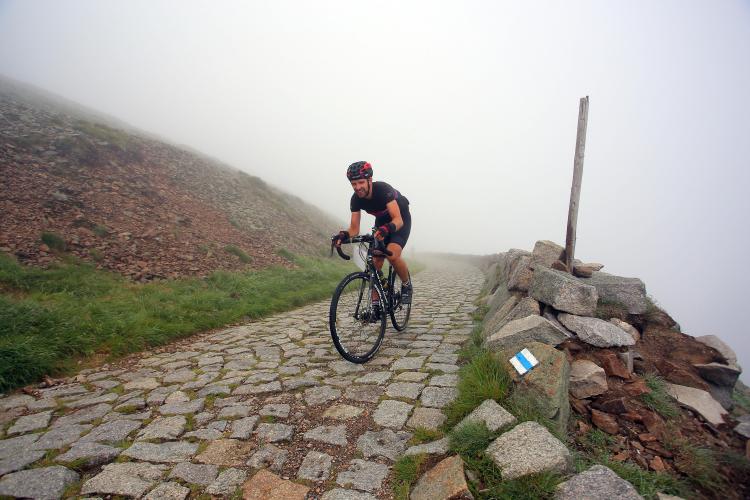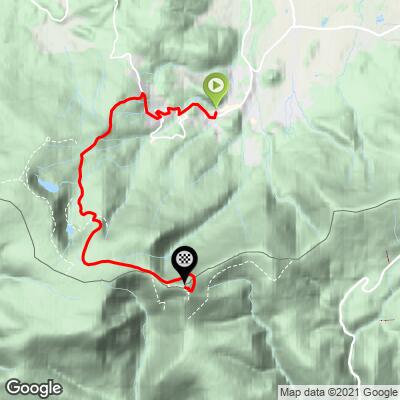![]()
Summary from our Legendary Mountains co-author Ties Arts, Bussum, Netherlands.
On the border between Poland and Czechia Republic you find the Karkonosze Mountains. The highest peak is Mount Snezka (Czechia) 1603m. It’s Mount Sniezka in Polish and Schneekoppe in German. This mountain has a history that goes way back, since 1456 there were activities and buildings.
![]()
Today there is the The Polish meteo observatory, a restaurant and it’s a touristic attraction (trials, skilifts etc). And there is a road. A cobbled road! (laid down by prisoners in world war II)
![]()
12,8km of cobbles from Karpacz (in Poland) going up to Mount Sniezka. And these cobbles are beyond the French or Belgian cobbles. These are bigger and rougher.
![]()
Can you do this with a race bike? We recommend an endurance bike with 32mm tires with profile. And use climb gearing….there are many sections >15% or even 20%+, so remaining on your bike without hitting the surface with your feet is a challenge on its own. Calculations from the University of Munchen (Holzel et all 2012) have made clear that these tough cobbles make a climb 50% more difficult. So the FIETS index of 9.2 is not representative. Only the true heroes can conquer this challenge.
Then there is another challenge? Generally, the road is not open for cyclists. It is officially only accessible for hikers. So if you go you risk a penalty - unless you attend the annual Sniekza uphill race. Officially only for MTB, but one can use a road bike if you dare - no guts, no glory! And that is what Sven Bartels from Berlin Germany did in 2016. He proved that you can go up with a racebike!
![]()
Sven Bartels, Berlin, Germany
Continue reading Sven’s unique and compelling story of his successful attempt.
Sven Bartels, Berlin, Germany - his Sniezka Uphill Race 2016: Indians in the fog article.
![]()
Ever since my first visits to the Czech area called Krkonošský národní park, I was attracted by its highest peak the Sněžka or the Schneekoppe as it was called in its short German history.
![]()
With 1603 m it's the highest point of the Czech Republic and separates the country from Poland by the borderline running right across its summit. I started looking for a way to get up there with my road bike. I soon found out about a possibility leading over the historic, cobbled road from the north, starting in Karpacz (Poland). As I deepened my researches, I stumbled across different multiple failed attempts to reach the summit by road bike always summed up in the statement that it's rather not possible to get up there on small tires. Those opinions encouraged my own attempt to prove them wrong. The only problem remaining, besides getting up the 1000Hm on an 10 km long rough cobbled road with gradients often above 20%, was the ban of bicycles in the whole area of the Krkonošský národní park to preserve its natural beauty. There are high fines to be paid if you get caught by the ever present Parc Rangers. The only way to bypass this rule is to start in the Sznezka Uphill Race, an MTB-Race hold once in the year with a small starter field.
Somehow I managed to get one of these in 2016 and found myself at the starting line in Karpacz early in the morning, equipped with a Cannondale Road bike with 50/36 11/32 and a pair of Schwalbe Samy Slick tyres among a crowd of MTB's and fat bikes. Rain was pouring but could not wash away my motivation to reach this unique summit. After the start I easily conquered positions climbing up the tarmac slopes leading out of Karpacz to the beginning of the cobbled section near the wooden church Wang. Usually there is a closed barrier here protected by some rangers, but this day the barrier was open and the rangers cheered at the cyclist passing by. Immediatly the real climb began with gradients rising to 20% on really incomparable cobbles. The road was created by prisoners of the Nazis when they occupied this area, to enable a way to reach the top by car. The stones are rather large and bulky with different sizes and shapes. While the road isn't used regularly in newer days the condition had suffered a lot. There are stones reaching out of the surface by 10 to 20 cm and parts where there are deep and large holes.
![]()
The cobbles are often covered by moss or grass which makes them very slippy. Especially on this day during the rain. I managed to make it up this section with a lot of effort but had to step off my bike because a lot of the mountain bike riders struggled with the gradient and stopped unexpected right in front of me. I couldn´t get back on my bike because of the steepness and had to find another way. I climbed up a small rampart beside the road and clipped in grasping a tree. I took some swing rolling downhill the rampart and managed to get this momentum into the steep section and find my rhythm again. Soon after that the group was reduced in size and I could easily pick my line over the cobbles from there. After a torturous enduring effort at the edge of my rear sprocket I left the wood but couldn't see anything beyond 3 meters.
Dense fog covered the further way. This made it easier as I couldn't see what's waiting in front of me and I could just focus on getting over the stony obstacles leading up the mountain. I had to go deep with every pedal stroke as the climb rarely felt beneath 10% gradient. All out of nothing and after I haven't passed any cyclist for a while, out of the fog there manifested an Indian right in front of me, wearing a chief wig and suiting dress riding cosy on an MTB. I was wondering if my mind played tricks on me because of the continuing physical exertion the climb demanded so far. Then I heard cheers like “ Dawai, Dawai Indiani“ (polish: Allez, Allez!) and knew that this is real. After the race I found out that there’s is a special price for the best costume. Not my category as I was looking for the satisfying thought, being among the first persons ever to reach the Sznezk by road bike, to finally become real.
![]()
Soon after this encountering I reached the plateau with a short downhill part. It was impossible to take this section at full speed as my wheels where bumping all over the irregular cobblestones. I was forced to take it very carefully to avoid a crash and was passed by lots of the other MTB cyclists. I really enjoyed the relieving moment when I hit the flat section in front of the Dom Śląsk hut where I could rest my legs for a few moments before the final part called the Jubiläumsweg started. The fog in front of me disappeared continuously as the climb itself and gave sight to the summit. With a fantastic view i crawled up the road, which was now in a much better condition. The stones were more regular and the surface rather flat, but the gradient still brutal above 10% and consistently rising to the climax of 30% in the last corner. The top was crowded by the participants who already reached the finish line. They were cheering at the remaining contesters. With this encouragement I put all my effort in the last pedal strokes up that small steep ramp but was stopped by a finalist crossing spontaneously the road to change sides a few cm before the finish. As a result I had to push my bike for half a meter before I got back on it and tumbled over the deserved finish line. I did it! With proud, relief and happiness I joined the other finalist and laid down in the grass and had some cool beverage. Not knowing that the biggest challenge was yet to come. The Descent!
![]()
What goes up must come down.
During the climb I had decided to avoid any downhill riding on this surface and to look for another possibility to return to Karpacz. I knew that there was a chair lift going down which I wanted to take in this case. Neither did I know if it's open nor where it was located or if it's possible to take the bike with you. I skipped the organized neutralized downhill ride with the other participants and started to look for the lift. The fog dense once more and I could hardly see more than one meter. I got back to the hut and started to ask the people there for the lift. I couldn't get an useful information but remembered some hiking signs nearby and followed them into the fog not knowing what they say or where they would lead me. I walked for a while when I suddenly noticed a screeching sound. I decide to investigate its source and after a few minutes of wandering blindfolded through the fog I stood in front of the lift. I asked a grumpy looking guy standing next to a rusty and worn lift engine if it was possible to take my “rower“ (bike) with me. He showed me the way how this was possible. I was asked to put my bike in front of me and an wait for the next chair. The seat neared and i sat down and raised my bike carrying it in front of me .
With both hands on the bike I couldn't close the safety frame and sat loose in the chair clinching my frame and trying to balance everything while the lift headed into the fog. My thoughts went through the ride so far and circled around some warming bath when suddenly with a short jolt the lift stopped and stood still. It seemed like forever and Karpacz an eternity away. Fearful thoughts started to rise inside my mind. Power break down? Did they just turn off the lift not knowing that people were still inside? How should I get down, not knowing how far the bottom ,which was hidden by the fog is away from my seat. My arms slowly started to hurt and i felt problems holding my bike in this uncomfortable position. My chair was swinging left to right and back through the embracing fog and the metallic screeching it produced this way was the only sound breaking the surrounding silence. I was thinking about dropping my bike down below when all of a sudden the lift started to move again after a few minutes. As if nothing had happened I got out of the fogs a few moments later and saw Karapacz under my feet. I reached the bottom with exhausted arms and a tremendous heartrate and left my seat. I deeply sighed and concluded having experienced one of the shortest(10 km) but most intense rides I ever did.
![]()
Thank you Sven Bartels!!

 We've partnered with Sherpa-Map.com to bring you the best route planning tool. With a PRO Membership you can use this climb as a reference when creating your route.
We've partnered with Sherpa-Map.com to bring you the best route planning tool. With a PRO Membership you can use this climb as a reference when creating your route. 

